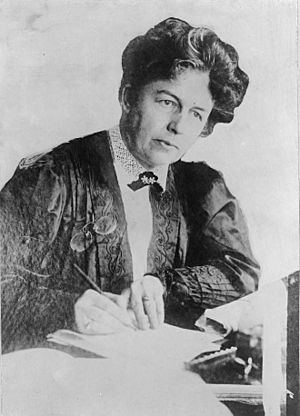Harriot Stanton Blatch facts for kids
Quick facts for kids
Harriot Stanton Blatch
|
|
|---|---|
 |
|
| Born |
Harriot Eaton Stanton
January 20, 1856 Seneca Falls, New York, U.S.
|
| Died | November 20, 1940 (aged 84) Greenwich, Connecticut, U.S.
|
| Alma mater | Vassar College |
| Occupation |
|
| Spouse(s) |
William Henry Blatch Jr.
(m. 1882; died 1915) |
| Children | 2, including Nora Stanton Barney |
| Parents |
|
Harriot Eaton Blatch (born Stanton; January 20, 1856–November 20, 1940) was an American writer and a leader in the suffrage movement. This movement worked to gain voting rights for women. Harriot was the daughter of Elizabeth Cady Stanton, a very important women's rights activist.
Contents
Early Life and Education
Harriot Eaton Stanton was born in Seneca Falls, New York. She was the sixth of seven children. Her parents, Elizabeth Cady Stanton and Henry Brewster Stanton, were both active in social causes.
Harriot went to Vassar College and earned a degree in mathematics in 1878. After college, she studied at the Boston School for Oratory. She then spent about a year in Germany, working as a tutor for young girls.
Life in England
While traveling back to the United States, Harriot met William Henry Blatch, Jr., an English businessman. They married in 1882 and lived in Basingstoke, England, for 20 years. William worked as a brewery manager there.
They had two daughters. Sadly, their second daughter died at age four. Their first daughter, Nora Stanton Blatch Barney, also became a suffragist. She was the first woman in the U.S. to earn a degree in civil engineering. William Blatch died in 1915 from an accidental electrocution.
In 1881, Harriot worked with her mother, Matilda Joslyn Gage, and Susan B. Anthony on a book called History of Woman Suffrage. She wrote a big part of the second volume. In her writing, she included the history of the American Woman Suffrage Association. This group was a rival to her mother's and Susan B. Anthony's group. Her work helped bring the two organizations closer together.
While living in England, Harriot studied the lives of working women in rural areas. For this work, she earned her M.A. degree from Vassar College. She also worked with English groups that wanted to improve society. These included the Women's Local Government Society and the Fabian Society. She also joined the Women's Franchise League. There, she learned new ways to organize people, which she later used in America.
Fighting for Women's Vote
When Harriot returned to the United States in 1902, she wanted to make the American women's suffrage movement stronger. The movement had slowed down. She first joined the leaders of the Women's Trade Union League.
In 1907, she started her own group called the Equality League of Self-Supporting Women. This group was later renamed the Women's Political Union. Its goal was to get working class women involved in the fight for the right to vote. The group grew to include 20,000 factory, laundry, and clothing workers from the Lower East Side of New York City. This organization successfully pushed for equal pay for teachers in New York.
Leading Protests
Through her group, Blatch planned and led the 1910 New York suffrage parade. She was very good at getting many working-class women to join. She also worked with important women from high society. Harriot could organize strong street protests. At the same time, she worked behind the scenes in politics. She helped stop the opposition from Tammany Hall politicians, who worried women would vote for a ban on alcohol.
During her years fighting for women's rights, Blatch also wrote a book. It was called Mobilizing Woman Power. This book encouraged women across the United States to understand their important role in society.
Her Union became very powerful politically. They actively pushed for a change to the New York state constitution to give women the right to vote. This was achieved in 1917, after Tammany Hall stopped opposing it. In 1915, Blatch's Women's Political Union joined with Alice Paul and Lucy Burns' Congressional Union. This group later became the National Woman's Party.
War and After
During World War I, Harriot Blatch focused on helping with the war effort. She led the Woman's Land Army of America. This group provided extra farm workers during the war. In 1918, she wrote Mobilizing Woman Power. This book was about women's roles in the war, and it urged women to "go to work."
In 1920, she published A Woman's Point of View. In this book, she wrote about her pacifist views because of the terrible destruction caused by the war.
After the Nineteenth Amendment passed in 1920, women gained the right to vote. Blatch then joined the National Woman's Party. She worked to pass the Equal Rights Amendment. This amendment would ensure equal rights for all Americans, regardless of sex. She also joined the Socialist Party. She was nominated for New York City Comptroller and later for the New York State Assembly, but she did not win these elections. She eventually left the Socialist Party because it supported special laws for women workers. During the 1920s, Blatch also worked for the League of Nations. She suggested ways to improve the League's rules.
Later Life and Death
In 1939, Harriot Blatch broke her hip. She then moved to a nursing home in Greenwich, Connecticut. Her life story, called Challenging Years, was published in 1940. She passed away in Greenwich in November of that same year.
Images for kids
See also
 In Spanish: Harriot Stanton Blatch para niños
In Spanish: Harriot Stanton Blatch para niños


